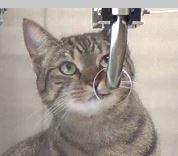Abstract

The behavior and facial expressions performed by cats have been reported to be visibly affected by the perceived taste quality of a food item. The goal of the present study was to assess how cats react to pleasant and unpleasant tastes. The facial and behavioral reactions of 13 cats to different concentrations of L-Proline and quinine monohydrochloride as well as mixtures with different concentrations of the two substances were assessed using a two-bottle preference test. The cats were videotaped during the tests and the frequency and duration of 50 different behaviors was analyzed in Noldus the Observer XT.
The cats responded to tastes regarded as pleasant by having their eyes less than 50 % open for significantly longer periods of time compared to a water control. Tongue protrusions were also observed significantly more frequently when the cats sampled from a solution with a preferred taste compared to a water control.
When encountering solutions of quinine monohydrochloride or mixtures containing quinine monohydrochloride the cats were observed to perform tongue protrusion gapes much more frequently compared to a water or L-Proline control. Even though the cats did not significantly differ in the number of times they licked at spouts containing the 50 mM L-Proline and 500 mM quinine monohydrochloride mixture compared to a 50 mM L-Proline, no masking effect could be confirmed as there was no increase in the acceptance of the mixture was observed.
The present study suggests that the knowledge about behavioral responses to pleasant or unpleasant taste can be utilized in future studies on how cats perceive different tastes.
Responsible for this page:
Director of undergraduate studies Biology
Last updated:
05/18/15
